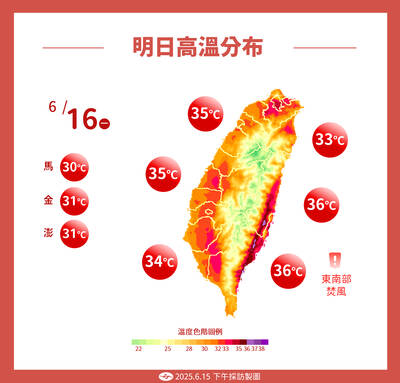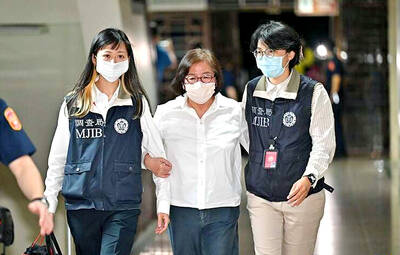The crash yesterday of a China Airlines Co (
The worst crash in the airline's history was the Nagoya crash on Apr. 26, 1994, in which 264 people on board were killed and 11 people on the ground injured.
A French-made Airbus A300-600R burst into flames at Nagoya International Airport when it stalled on its approach and crashed short of the runway.
The second worst crash until yesterday was on Feb. 16, 1998, when another A300-600R crashed into a residential area during its second landing attempt at the CKS International Airport (
The crash, which occurred at night, with visibility further reduced by rain and fog, killed the 197 people on board and seven on the ground.
Yesterday's flight CI-611 was scheduled to carry 225 people from Taipei to Hong Kong. At press time, more than 100 bodies had been found in the Taiwan Strait near Penghu, and rescue crews were still searching for survivors.
"We will definitely try our best to find more survivors, and we are hopeful," a spokesman at China Airlines who wished to remain anonymous said. "We are hoping it will not become the second worst crash in our history."
The spokesman said that the only 747-200 jumbo jetliner in the company's fleet had passed a detailed security check on Nov. 25 last year and another two minor checks on May 4.
"It was the only and last 747-200 we had. In the meantime, we will have to make further investigations before we can confirm the cause of the crash," he said. "However, technical problems probably aren't involved in this tragedy."
China Airlines' first crash occurred on Feb. 2, 1969, when a domestic DC-3 rammed into mountains in adverse weather conditions in Taitung, killing 24 people on board.
On Nov. 4, 1993, another Boeing 747-400 overshot the runway when landing at Hong Kong International Airport and ended up in the sea. No one was killed but 23 people on board were injured.

Costa Rica sent a group of intelligence officials to Taiwan for a short-term training program, the first time the Central American country has done so since the countries ended official diplomatic relations in 2007, a Costa Rican media outlet reported last week. Five officials from the Costa Rican Directorate of Intelligence and Security last month spent 23 days in Taipei undergoing a series of training sessions focused on national security, La Nacion reported on Friday, quoting unnamed sources. The Costa Rican government has not confirmed the report. The Chinese embassy in Costa Rica protested the news, saying in a statement issued the same

Taiwan is to extend its visa-waiver program for Philippine passport holders for another year, starting on Aug. 1, Minister of Foreign Affairs Lin Chia-lung (林佳龍) said on Friday. Lin made the announcement during a reception in Taipei marking the 127th anniversary of Philippine independence and the 50th anniversary of the establishment of the Manila Economic and Cultural Office (MECO) in Taiwan, the Ministry of Foreign Affairs said. The decision reflected Taiwan’s commitment to deepening exchanges with the Philippines, the statement cited Lin as saying, adding that it was a key partner under the New Southbound Policy launched in 2016. Lin also expressed hope

Temperatures in New Taipei City’s Sindian District (新店) climbed past 37°C yesterday, as the Central Weather Administration (CWA) issued heat alerts for 16 municipalities, warning the public of intense heat expected across Taiwan. The hottest location in Taiwan was in Sindian, where the mercury reached 37.5°C at about 2pm, according to CWA data. Taipei’s Shilin District (士林) recorded a temperature of 37.4°C at noon, Taitung County’s Jinfeng Township (金峰) at 12:50 pm logged a temperature of 37.4°C and Miaoli County’s Toufen Township (頭份) reached 36.7°C at 11:40am, the CWA said. The weather agency yesterday issued a yellow level information notice for Taipei, New

CASE: Prosecutors have requested heavy sentences, citing a lack of remorse and the defendants’ role in ‘undermining the country’s democratic foundations’ Five people affiliated with the Chinese Nationalist Party (KMT), including senior staff from the party’s Taipei branch, were indicted yesterday for allegedly forging thousands of signatures to recall two Democratic Progressive Party (DPP) lawmakers. Those indicted include KMT Taipei chapter director Huang Lu Chin-ru (黃呂錦茹), secretary-general Chu Wen-ching (初文卿) and secretary Yao Fu-wen (姚富文), the Taipei District Prosecutors’ Office said in a news release. Prosecutors said the three were responsible for fabricating 5,211 signature forms — 2,537 related to the recall of DPP Legislator Wu Pei-yi (吳沛憶) and 2,674 for DPP Legislator Rosalia Wu (吳思瑤) — with forged entries accounting for